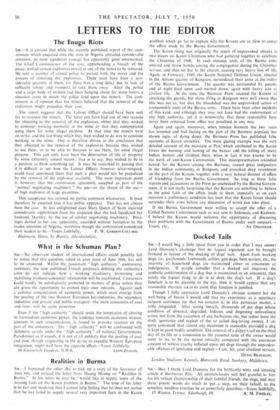Realities in Burma
SIR,—I happened the other city to pick up a copy of the Spectator of June 6th. and noticed the letter from Maung Mating on " Realities in Burma." In his letter he says he "would like to supply some of the missing facts on the Karen problem in Burma." The tone of his letter is so fair and moderate that I cannot help feeling that he does not realise' that he has failed to supply several very important facts in the Karen
problem which go far to explain why the Karens are so slow to accept the offers made by the Burma Government.
The Karen rising was originally the result of unprovoked attacks in two places on Karen'Cbristians who had gathered together to celebrate the Christmas of 1948. In each instance units of the Burma army entered and threw bombs among the congregation during the Christmas service, and then set fire to the church, causing very heavy loss of life. Again, in February, 1949, the Karen National Defence Union, situated in the Ahlone quarter of Rangoon, surrendered their arms at the orders of the Burma Government. The quarter was surrounded by guards, and at night tired upon and burned down, again with heavy loss of civilian life. At the time the Burmese Press accused the Karens of attacking the guards, but those living in Rangoon were well aware that this was not so, but that the bloodshed was the unprovoked action of irresponsible units of the Burma army.. There have been other incidents of this kind, and although they may not have had the endorsement of any high authority, yet it is noteworthy that those responsible have never been removed from office nor penalised in any way.
Again and again, moreover, when tension between the two races has lessened and bad feeling on the part of the Burmese populace has shown signs of dying down, the Burmese Press has published false accounts of Karen atrocities. The most glaring example was the very detailed account of the massacre at Pyu, which attributed to the Karen forces the burning and looting of the bazaar and the killing of many Indian women and children there, when in fact it was known to be the work of anti-Karen Communists. This misrepresentation rekindled hatred for the Karens among the Burmese, roused great indignation in the Indian community in Rangoon, and provoked deep resentment on the part of the Karens, together with a very natural distrust of offers of friendship from the Burma Government. So long as these' false reports and accusations in the Press go unchecked by the Burma Govern- ment, it is not really-surprising that the Karens are unwilling to believe in the good faith of the offers made to them, especially as on each occasion a preliminary condition has been that the Karen forces should surrender their arms before any discussion of terms can take place.
If the Burma Government were willing to accept the offer of .a United Nations Commission such as was sent to Indonesia and Kashmir, I believe the Karen's would' welcome the opportunity of discussing their problems with the Government of Burma under such auspices.—






































 Previous page
Previous page